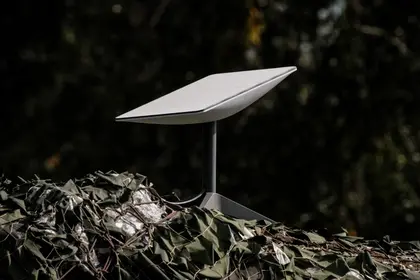Russian forces have begun installing warheads in their foam-plastic “Gerbera” drones, which were initially designed as decoys to mislead air defense systems, Ukrainian electronic warfare specialist Serhii Beskrestnov, known as “Flash,” reported on Telegram, sharing photos as evidence.
The Gerbera UAV is a lightweight, low-cost drone with a 2-meter (6.6-foot) length, 2.5-meter (8.2-foot) wingspan, and a weight of about 10 kilograms (22 pounds) It has a flight range of up to 300 kilometers (186 miles) without a warhead and costs approximately $10,000 per unit.
JOIN US ON TELEGRAM
Follow our coverage of the war on the @Kyivpost_official.
“An important update for mobile fire teams, rescuers, police, and the military: The white foam-plastic ‘Gerbera’ drone used to deceive air defenses is now being fitted with various types of warheads,” Beskrestnov wrote.
According to him, the drone can carry different types of warheads weighing up to 5 kilograms (11 pounds). He shared a photo of a Gerbera drone containing a high-explosive fragmentation warhead weighing 2.5 kilograms (5.5 pounds), installed in its nose.

Ukraine Strikes ‘Like a Bolt From the Blue’ in New Kursk Offensive, Russian Reports Say
The Defense Express media outlet said that during a demonstration in July 2024, Russian developers had already showcased the possibility of arming these drones and using them as loitering munitions. It was also planned to equip the UAVs with cameras and communication systems.
In a simplified version, the Gerbera can function similarly to the Iranian-designed Shahed drones, flying toward pre-programmed coordinates stored in memory.
“Additionally, there is a risk that the enemy may install timed detonators, causing the drone to self-destruct after a certain period,” Defense Express wrote.
The report further emphasized that examining the wreckage of these drones independently could be extremely dangerous. Given the low accuracy, crude design, and cheap electronic components, Russian forces might deliberately use Gerbera drones to strike civilian areas where precision is less critical.
A budget version of the Shahed
The Gerbera has been described as a simplified, low-cost alternative to the Iranian Shahed-136, which Russia has rebranded as the Geran-2. The first sightings of this new Russian drone were reported in mid-July 2024. On July 24, Ukrainian air defenses shot down a Gerbera over Kyiv for the second time. The drone crashed in open terrain and remained mostly intact, allowing for further analysis.
“It looks like a budget version of the Shahed – plywood instead of composites, minimal components, all the same cheap ‘Made in China’ parts,” Vladyslav Vlasyuk, an advisor to the Head of the Office of the President of Ukraine, wrote on social media.
Experts from Defense Express described the drone as being “assembled with very low production standards.” They found that its body was made of foam plastic, while its internal compartment was reinforced with plywood. Inside, they discovered navigation systems, control units, batteries, and even a 4G modem with a Ukrainian SIM card. However, the examined unit did not contain a warhead at the time.
Despite its rudimentary construction, Oleksiy Hetman, a retired National Guard major and veteran of the Russo-Ukrainian war, warned that such drones could still pose a serious threat.
“Because of its lightweight foam-plastic body, it would be difficult for radar systems to detect. If painted with certain materials, it could become even less visible. And if a silencer is installed on the engine, it would also be harder to hear,” Hetman said.
Andriy Chernyak, a spokesperson for Ukraine’s Military Intelligence (HUR), told Reuters that the Gerbera drones are extremely cheap to produce. While a single Shahed drone costs Russia up to $200,000, the Gerbera is estimated at just $10,000 per unit.
According to engineers at Ukrainian drone manufacturer Airlogix, the primary role of the Gerbera is to distract Ukrainian air defense systems from engaging more advanced UAVs. Additionally, they believe it could be used for kamikaze attacks on moving targets using FPV cameras.
Military analysts also suggest that Gerbera drones could serve as cheap “cover” for Shahed drones, increasing the chances of the more expensive UAVs reaching their targets. The simultaneous launch of multiple Gerbera drones could overload Ukrainian air defense systems, making it harder to intercept actual high-priority threats.
The Espresso media outlet reported that shooting down Gerberas with small arms is difficult, as they fly at altitudes of up to 1 kilometer (.6 miles), making them nearly impossible to hit with machine guns or rifles.
However, the drones remain vulnerable to electronic warfare, as jamming their control signals could prevent them from reaching their targets. Experts also said that intercepting these drones is not cost-effective, as the price of a missile used to destroy them often exceeds the drone’s own production cost.
You can also highlight the text and press Ctrl + Enter












